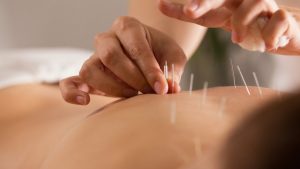The benefits of Dry Needling for lower back pain
 What is the difference between Dry Needling and Acupuncture?
What is the difference between Dry Needling and Acupuncture?
Acupuncture is based on traditional Chinese medicine, and Dry Needling is based on western medical research. It is called “dry needling” as there is nothing injected from the needle. The needle itself provides a physiological effect and changes the muscle.
What is Dry Needling used for?
Dry Needling is used to treat many different types of injuries and conditions, and its benefits are greatly supported by evidence-based literature. Let’s explore some of the benefits of dry needling below:
- Reducing muscle spasms with acute back pain
- Decreasing inflammation in osteoarthritic knees
- Decreasing swelling and inflammation with sprained ankles
- Faster recovery of muscle tears eg. Hamstring and calf tears
- Increases flexibility eg. Tight ITBs
- Helps to relieve headaches and migraines by untrapping nerves
How does it work?
Dry needling a muscle increases blood flow and circulation to muscle tissue that has been injured or overused. This enables the muscle tissue to move more freely and therefore reducing pain and improving function.
Why do we (physios) practice Dry Needling?
I will always use Dry Needling in addition to massage, ART and mobilisation.
- It is more comfortable for the client. It hurts less than my digging my elbow or thumb into a sore muscle!
- It treats an injury quickly as it is more specific when targeting a muscle trigger point
Have you ever had a really hard remedial massage and the next day you feel “bruised”? That “bruised” feeling is because not only has the injured muscle tissue gone through the trauma of massage but so has the good uninjured tissue. With Dry Needling, you will get no post-treatment soreness.
